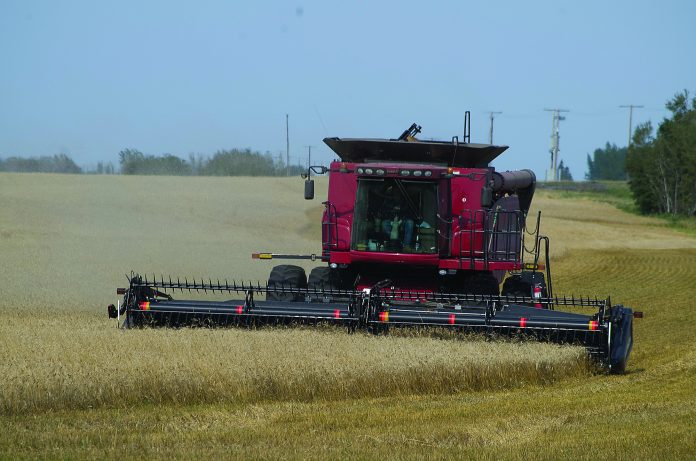
Ministry of Agriculture, Submitted
Producers have made the most of another dry week in Saskatchewan with harvest now 82 per cent completed. This is ahead of the five-year average of 64 per cent and the 10-year average of 62 per cent. Producers are hoping for timely rains once harvest is complete.
Harvest in the southwest is essentially complete with 97 per cent of the crop off. Only a few flax acres remain in the region. The west-central region continues to make great progress with 92 per cent of this year’s crop harvested. The southeast has 79 per cent, followed by the northeast and northwest at 75 per cent and finally, the east-central region has 66 per cent harvested.
Producers mainly focused on harvesting oilseed crops this week and made substantial progress. Canola is now 65 per cent complete across the province, up by 23 per cent over last week. Mustard is 97 per cent complete, soybeans are 47 per cent and flax is 39 per cent. Oat harvest has also progressed rapidly, with 79 per cent of the crop harvested, an increase of 21 per cent from last week. Durum is 94 per cent complete, barley is 92 per cent and spring wheat is 88 per cent. Chickpea harvest progressed, with 87 per cent of the crop off. Harvest of fall cereals, canary seed, peas and lentils is complete for the year.
Minimal rain was seen this week, with the Stoughton area receiving the most rain at 10 mm. The lack of significant rain led to topsoil moisture once again decreasing. Twenty-five per cent of cropland has adequate topsoil moisture, 49 per cent is short and 26 per cent is very short. Twenty per cent of hay and pastures have adequate moisture, 49 per cent is short and 31 per cent is very short.
Pasture conditions remain relatively unchanged. Twelve per cent of pastures are in good condition across the province, while 31 per cent are fair, 35 per cent are in poor condition and 22 per cent are in very poor condition. Producers will need multiple significant rain events to improve soil moisture for pasture quality to improve.
Crop damage continues to be caused by drought conditions and grasshoppers. This week crops were also damaged by light frosts, wind and wildlife.
Producers are currently busy with harvest, spraying post-harvest weed applications, working their fields and hauling grain. Many are also hauling bales, preparing feed for winter and marketing cattle.
Harvest is a very busy and stressful time for producers. They are reminded to take safety precautions in all the work they do. This includes having fire mitigation resources at the ready and taking precautions when working around powerlines. The Farm Stress Line is available to provide support to producers toll free at 1‑800‑667‑4442. The public is reminded to take extra caution, time and space when encountering machinery on the roads.
Northeastern Saskatchewan
Producers in the northeast made the most of the dry weather and have now completed 75 per cent of their harvest. This is ahead of the five-year average of 52 per cent.
Producers in the region have made great progress harvesting all crop types this past week and are now focusing on getting their oilseeds in the bin for the year. Fifty-five per cent of canola is harvested so far, while 18 per cent of flax is in the bin. Barley is 97 per cent complete, spring wheat is 93 per cent, oats are 86 per cent and canary seed is 62 per cent. Chickpeas are 51 per cent harvested for the year. Fall cereals, durum, lentils and field peas are completed for the year.
The Tisdale area received the most rain this week, recording 6.8 mm. Topsoil moisture in the northeast is still adequate. Seventy-five per cent of cropland has adequate topsoil moisture and 25 per cent is short. Two per cent of hay and pastures have a surplus of topsoil moisture, 66 per cent have adequate moisture and 32 per cent is short.
Pastures are in fair condition in the region, with 45 per cent rated as good, 54 per cent as fair and two per cent as poor.
Crop damage this past week is due to light frosts, waterfowl and wind. Producers are busy combining and working their fields for the fall. Producers are also working cattle, hauling bales and preparing for the winter.
Northwestern Saskatchewan
A dry week meant rapid harvest progress in the northwest region. Producers in the northwest have been busy combining this week and are now 75 per cent harvested for the year. This is ahead of the five-year average of 45 per cent.
Producers are completing their spring seeded cereals this week and turning their attention to their oilseeds. Barley is 85 per cent complete, spring wheat is 83 per cent and oats are 80 per cent complete. Sixty-four per cent of canola is in the bin for the year, while producers are waiting for flax to dry-down and have not yet started combining. Fall cereals, field peas and lentils are harvested for the year.
The St. Walburg area received the most rain this week, recording just three mm. Topsoil moisture is beginning to be limited, with 37 per cent of cropland having adequate moisture, 55 per cent is short and eight per cent is very short. Thirty-five per cent of hay and pastures have adequate moisture, 52 per cent are short and 13 per cent are very short.
Pastures are experiencing the effects of a dry summer. Thirteen per cent of pastures are in good condition, 46 per cent are in fair condition, 19 per cent are in poor condition and three per cent are in very poor condition.
Crop damage this past week is due to light frosts, waterfowl and wind. Producers are busy combining and working their fields for the fall. Producers are also hauling feed and bales, marketing cattle and preparing for winter.

